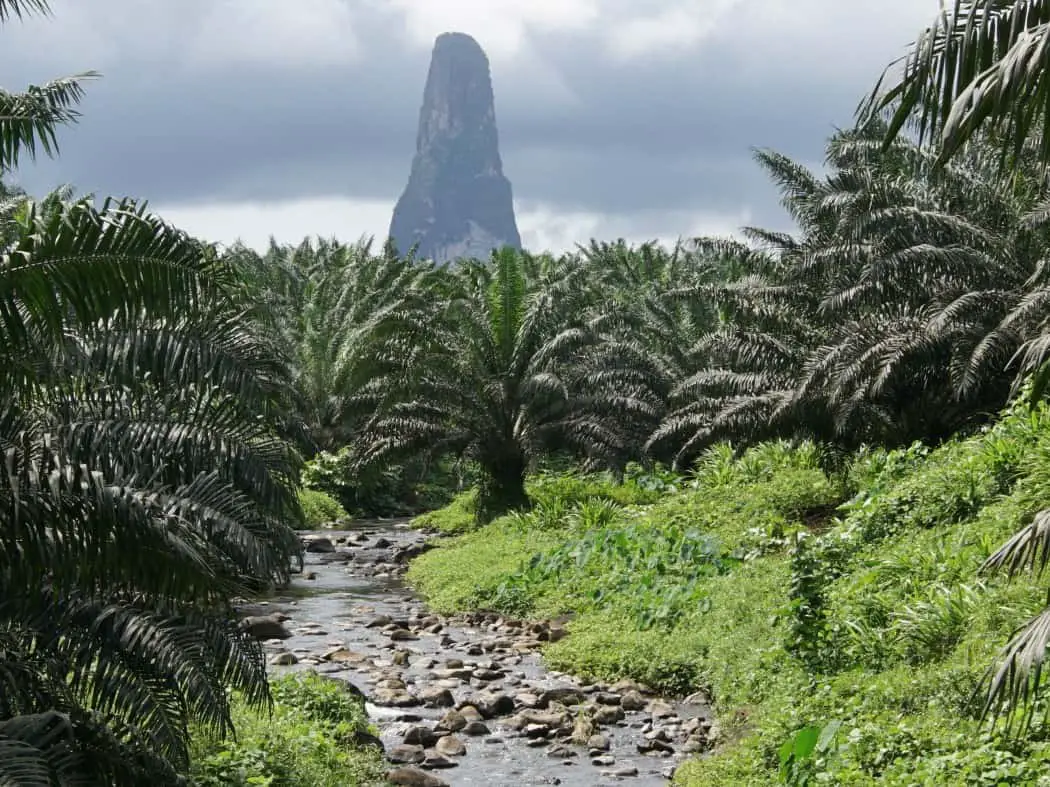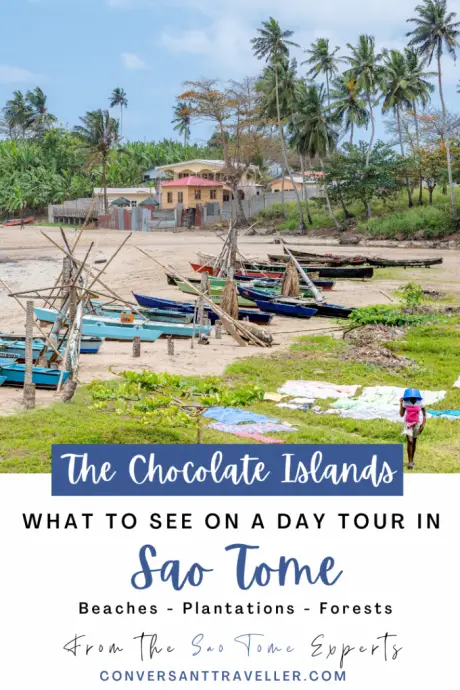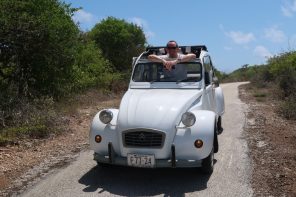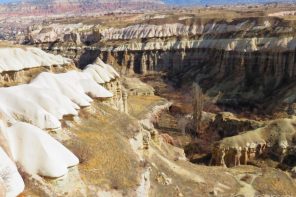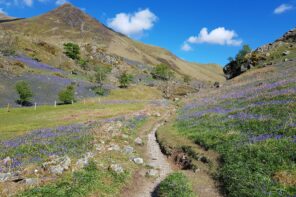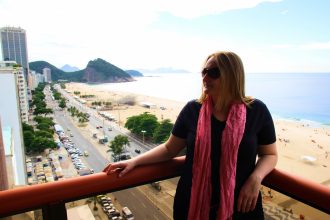A young mother sat on an upturned bucket in what remained of the hospital corridor at Roça Água Izé, singing a haunting Creole lullaby to her infant as he suckled contentedly at her bare breast. It was late afternoon on our São Tomé day trip and the shadows were already beginning to lengthen inside the damp plantation ruins. The air was heavy with humidity yet this didn’t seem to bother the woman who was tending a small fire with her spare hand. Checking the blackened pot to see if her water was boiling, she pushed it further into the flames and sat back, never once missing a note of her lament. Wood smoke hung like a veil, flirting with the shafts of light that penetrated the slatted rotting roof. The singer barely glanced up as we tiptoed past, reluctant to break the spell of this surprisingly intimate domestic scene.
Hubbie and I were enjoying a day trip on São Tomé, organised through our hotel, the delightful Omali Lodge. We’d touched down the evening before, and this was our first São Tomé day tour – we had no idea what to expect. Our bellies bursting with banana bread and coconut muffins from the breakfast buffet, we clambered into the well-used Landrover that was awaiting our pleasure out front with guide Agostinho and driver Carlito.
We had to sit sideways and brace ourselves against the motion for much of the journey, and the window level was so low we had to bend down if we wanted to look at the scenery. The roof wasn’t high enough for Hubbie to sit fully upright, and for once I enjoyed the benefits of being short. Yet despite the discomfort, it felt right. A flashy new vehicle with all the mod cons would just be so out of place here, and we wanted a real experience during our São Tomé day trip, bumps and all.
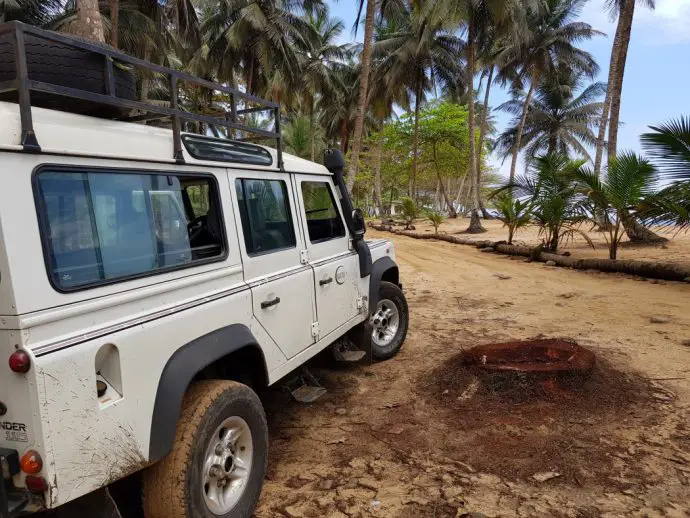
Read More: Review of a stay at Omali Lodge on São Tomé
Table of Contents
A Southern São Tomé day trip
We chose the southern São Tomé tour because it visited a variety of different attractions, from beaches and cacao plantations to mangroves and local fishing villages. We only had one full day to explore the island, having opted for longer on Príncipe, so wanted to pack in as much as we could. In hindsight we should have had at least a couple of days on São Tomé, because whilst it isn’t quite as ‘wild’ as its sister island, there’s a lot to see and do. And it’s stunning!
This post is a bit of a whopper. There’s very little information online about what it’s really like to visit São Tomé and Príncipe so I wanted to share our whole experience with those thinking of travelling to the islands. If you’d rather just skip to a specific section, or just ogle the pretty pictures, then feel free to navigate using the menu above.
First impressions of São Tomé
Heading south from Omali Lodge (which is not far from the airport) on our São Tomé excursion we were soon in the countryside. The entire island feels like one giant plantation, with cacao, coffee, vanilla, papaya and manioc growing in the forest everywhere you look. If you’re into bananas you’ll love São Tomé – apparently there are seven different varieties grown here.
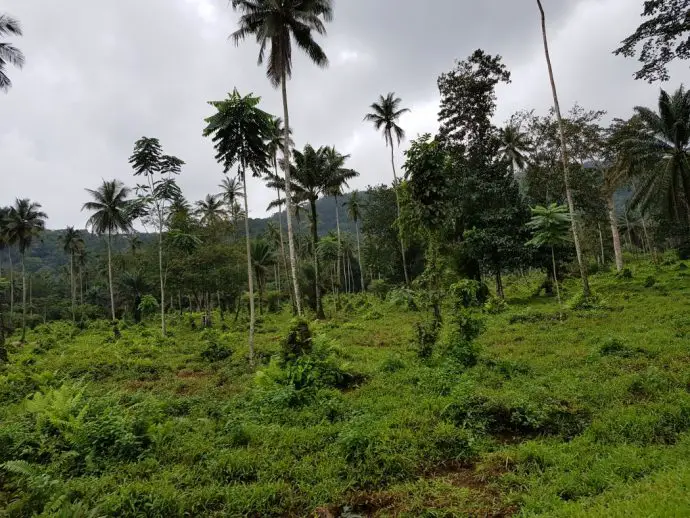
There was very little traffic on the road, and we only passed a handful of vehicles during the entire day. None of them were tourists, so it really felt like an intrepid adventure, heading off into the unknown.
The villages seemed poor yet had a rustic beauty, with wooden huts, many of them half finished, lining the verges. Most people were barefoot, just sitting around in the intense heat, as if waiting for time to pass. No-one and nothing moves fast here, because there’s really no reason to. The nation’s slogan is ‘leve-leve’ (slowly- slowly) after all. Life here is simple and honest, and we could all learn a thing or two from it. The children, meanwhile, seemed to have the lion’s share of the energy as they flew past on homemade wooden scooters, chasing chickens.
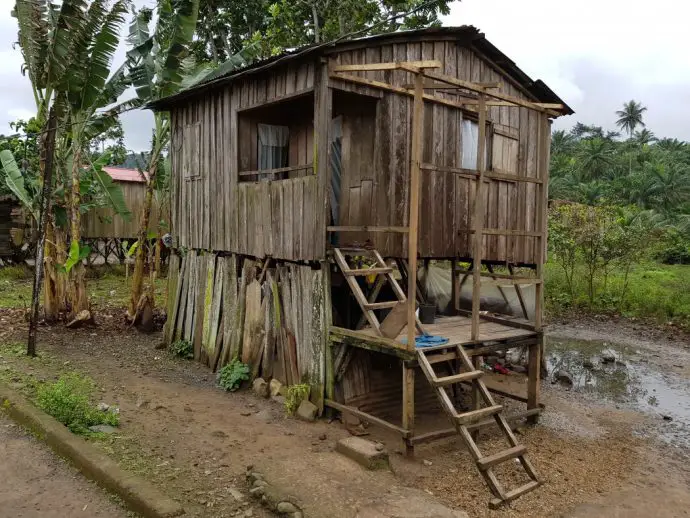
Most places in the tropics are magnets for feral dogs. Not here. In São Tomé and Príncipe it’s pigs! We must have seen hundreds of them, snuffling around in the bushes at the side of the road, or sunning themselves right in the middle of the highway. Presumably they belong to someone but there was never anyone around.
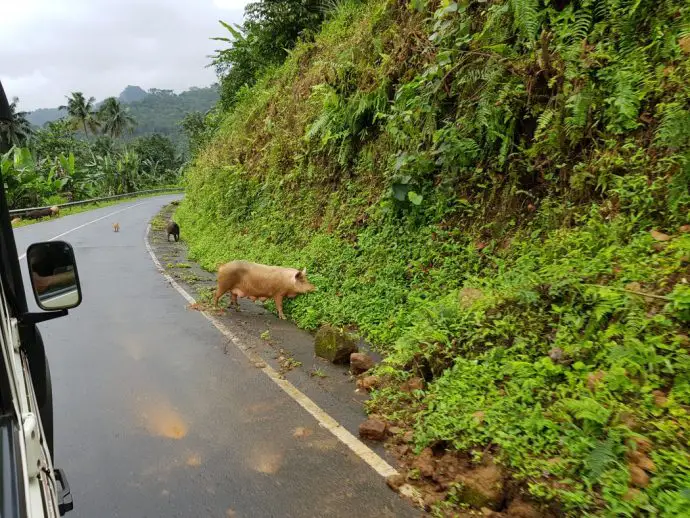
We often encountered debris on the road which slowed the journey considerably. There was an element of excitement in never knowing what lay around the next corner, but it did mean we spent a long time in the vehicle. We were travelling at the end of the dry season, and the heavens had opened a little early so torrential rain was an on-off companion throughout our day trip on São Tomé. It became a regular occurrence to come across entire palm trees sprawled across the road, the result of landslips brought on by the rain. Carlito took them all in his stride.
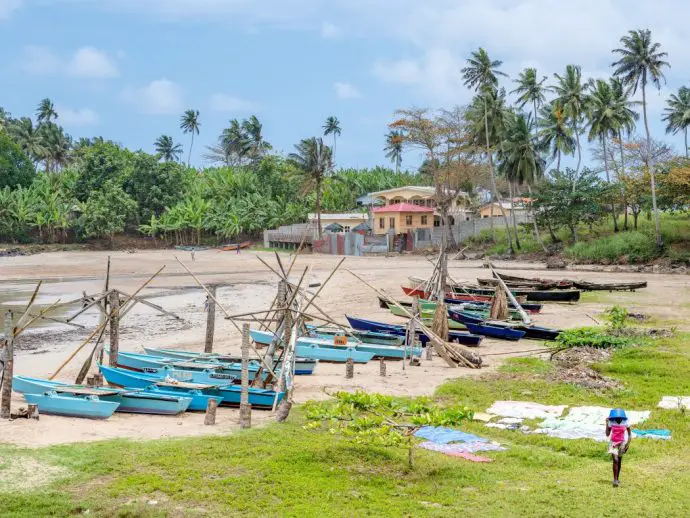
We passed through several small fishing villages, where men strode around with machetes and women washed clothes, and themselves, in the rivers. As Agostinho said “we may be poor, but we’re clean”. Whenever we stopped, people were friendly, greeting us with big smiles everywhere we went. We were naturally wary at first, being used to the fake welcomes that are a precursor to demands for money in so many parts of the world. Yet here it was different, and despite the language barrier we thoroughly enjoyed our interactions.
The highlights of a day trip on São Tomé
These are all the places we visited during our São Tomé tour. We were also supposed to take in the Boca do Inferno and the Pesqueira beach waterfalls. These stops never materialised despite being on the original hotel itinerary, and we have no idea why. But this is just what happens on São Tomé and Príncipe and as a visitor, you just have to learn to roll with it.
1. Pico Cão Grande
No São Tomé excursion is complete without a stop to admire the imposing rocky pinnacle of Pico Cão Grande. Looming through the swirling mists above Obô Natural Park, this needle-like volcanic plug towers 1,200 feet above the rainforest canopy, and is one of the most popular sights to include on your São Tomé day trip. Obô is the only national park in São Tomé and Príncipe, with virgin forest covering about 30% of both the islands. Endemic plant and bird biodiversity here is staggering, and draws scientists from around the world to study this unique habitat.
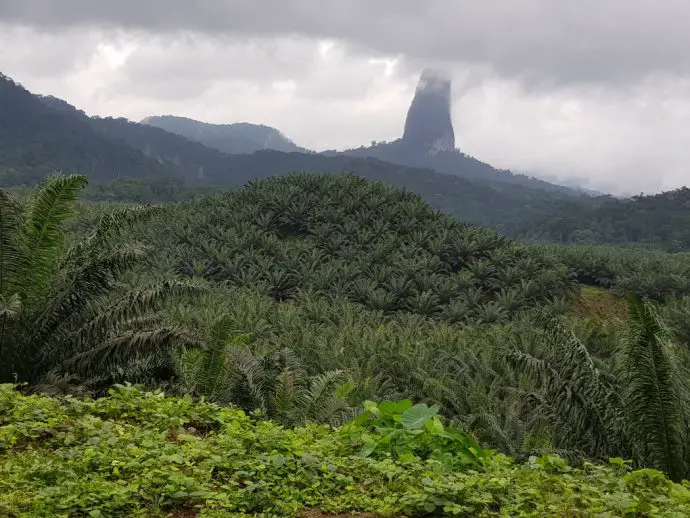
Wondering where to see Pico Cão Grande? The best place to view it is from the road as you travel south, so it’s almost impossible to miss. Unless the weather closes in and cloud hides it from view, which happens quite frequently. The national park is pretty impenetrable, although there are hiking trails for hardy explorers, and some climbers have even been known to scale the snake-infested peak. We decided that was an adventure for another day!
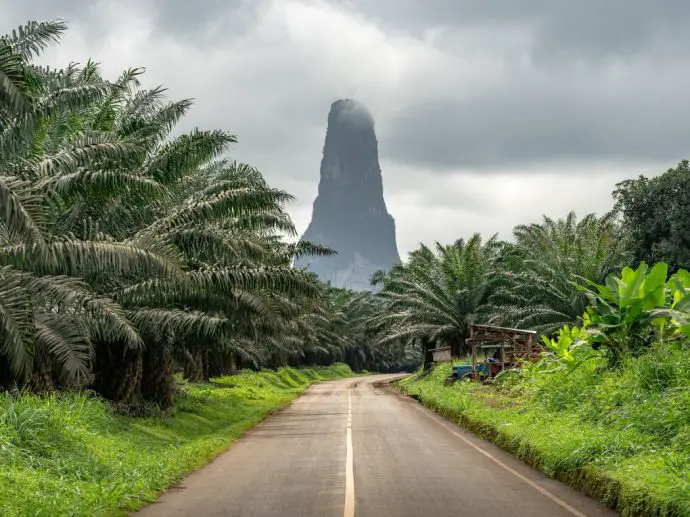
You will notice that the road here is surrounded by a palm oil plantation, which has been created by the Belgians to provide work for local people. However, they haven’t yet built a factory to process the oil, so the project is yet to have a major impact on the lives of those who live here. Watch this space!
2. Malanza River
We had no idea we’d be going for a canoe ride during our day trip on São Tomé, all we knew was that there was a stop on the itinerary at ‘Malanza’. Whatever that was. It turned out to be a mangrove river just north of Porto Alegre at the end of the road south. It was actually a lot of fun, but I wish we’d known earlier so we could have enjoyed the anticipation.
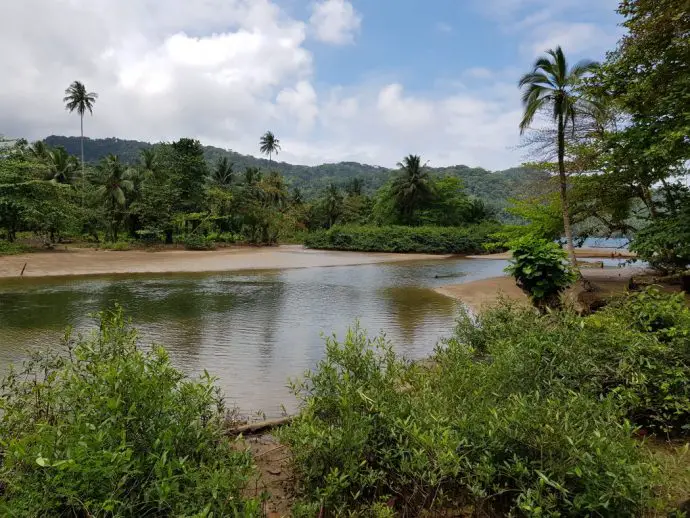
Our expert boatman paddled his enormous canoe (it was really more like a boat) stealthily through the mangrove channels, so we could keep an eye out for the wildlife that resides deep in this swampy land.
We were there at the end of the dry season in September so water levels were low, meaning some passages were trickier to navigate than others and we had a few low hanging tree limbs to duck under! It did mean we could see all the exposed tree roots which was pretty impressive, and it all felt very mysterious. Definitely a highlight of our São Tomé day tour!
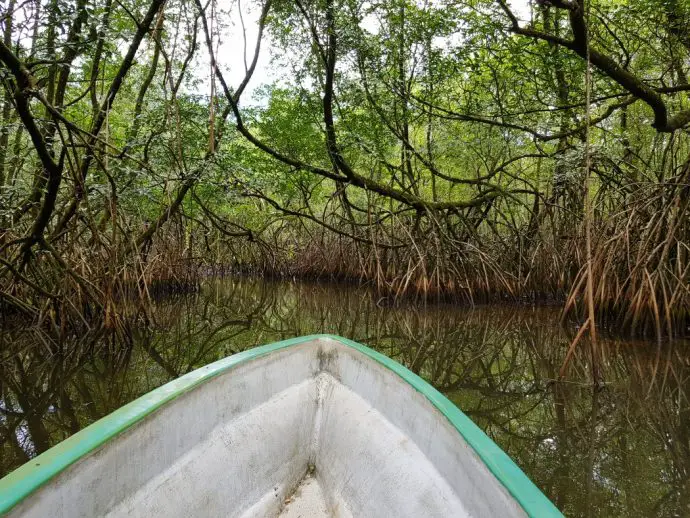
The boat trip took about an hour, and we spotted lots of kingfishers, monkeys, herons and egrets along the way. There were even pigs snorting around in the undergrowth, they seem to get everywhere, and I wondered if they could swim.
We saw children propelling themselves along on wooden rafts, trailing fishing lines behind them in the hopes of catching some lunch. They soon got bored of the labour and jumped into the water, splashing and shrieking like kids do the world over.
3. Porto Alegre
Next up was a brief stop in the Angolar village of Porto Alegre, which lies just a couple of kilometres from the southernmost tip of the island. This is pretty much the end of the road, with onward exploration done on plantation tracks.
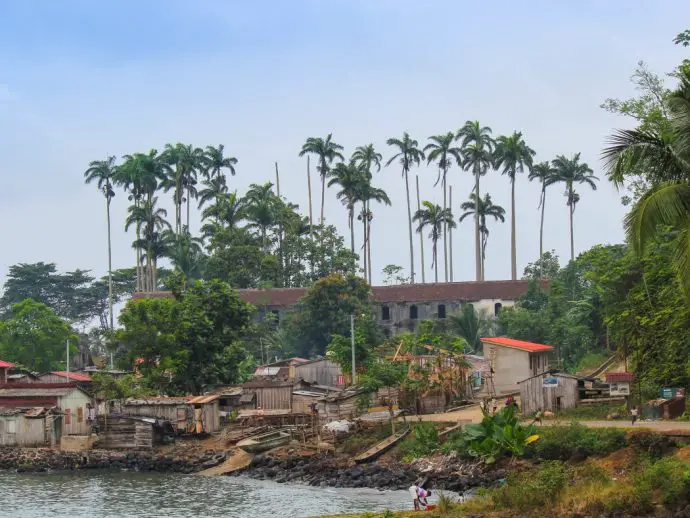
We stopped to chat to some fishermen who were chilling out after hauling in the morning’s catch. Fishing is the way of life here on the islands, and the villagers rely on the industry to supplement the crops they are able to grow on the land. It’s a tough but self-sufficient existence, mirrored in villages all around the islands of both São Tomé and Príncipe.
The name ‘Porto Alegre’ means ‘Happy Port’ in Portuguese, and indeed there were smiles all around as we passed by. We felt very conspicuous as white western tourists enjoying a day trip on São Tomé (we still hadn’t seen another foreign visitor), but despite their obvious curiosity, most people we met seemed interested that we’d made the effort to visit their tiny village.
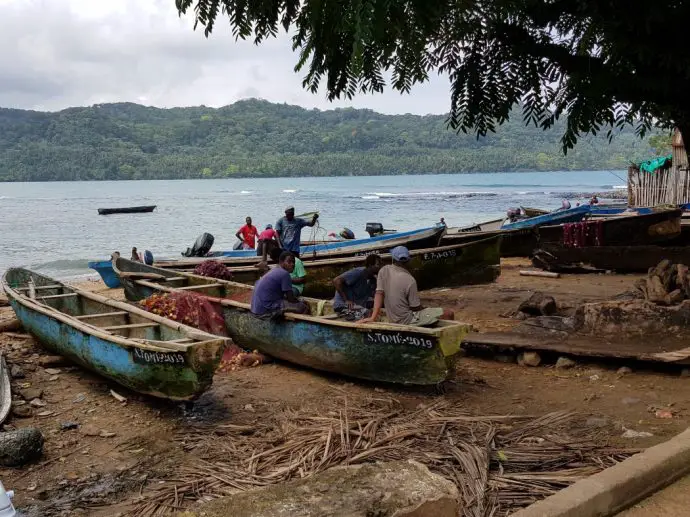
You can see remains of the Roça de Porto Alegre plantation, with several ruined buildings poking their heads out of the encroaching jungle. This plantation was once one of the largest on São Tomé, with access almost exclusively by sea thanks to its remote location.
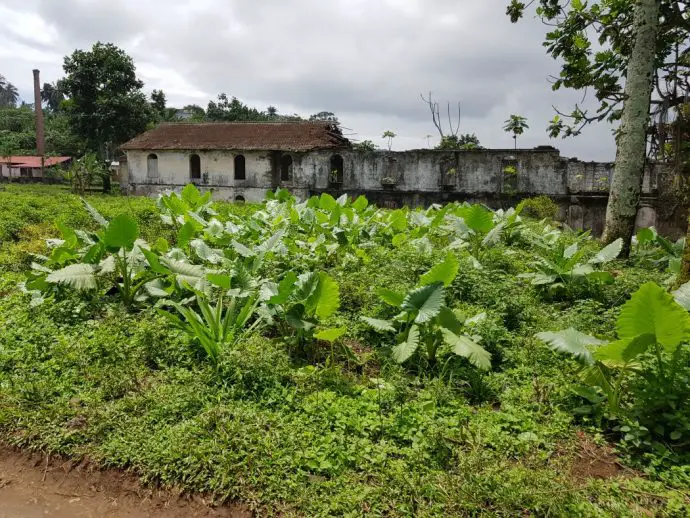
Read More: Things they don’t tell you about a São Tomé and Príncipe holiday
4. Praia Jalé
Of course by now we were itching to clap eyes on one of São Tomé’s famous beaches, and Praia Jalé ticked all the boxes. It’s gorgeous, wild and remote, and the only footprints left in the sand were ours. To reach the beach we drove for miles on plantation tracks – we’d have got completely lost had we been without a guide!
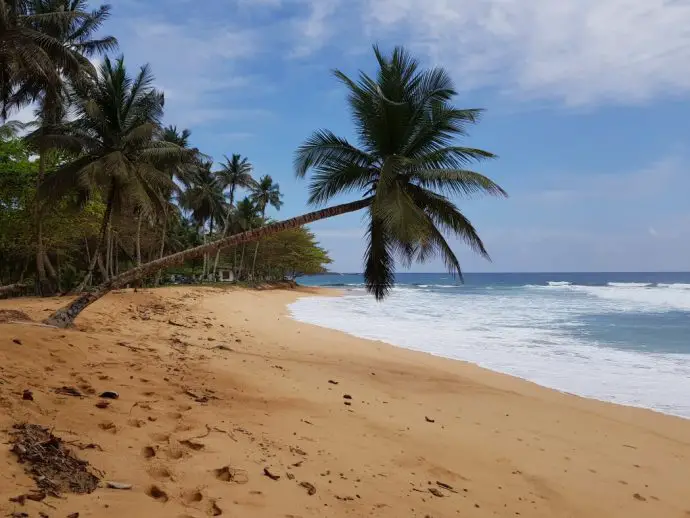
If you’re here between November and February, you will witness sea turtles arriving to lay their eggs on the beach here. Then up until the end of March, keep an eye out for the hatchlings emerging from the nests and scurrying down towards the sea.
If you fancy staying here and watching the turtles, Jalé Ecolodge offers rustic beachfront accommodation ideal for nature lovers and anyone looking for peace and seclusion. Visitors can help out the local team with the turtle protection programme and take part in nightly observations of nesting. You can just see one of the bungalows hidden in the trees in the image above.
5. Praia Piscina
Not far from Praia Jalé, along some more bumpy plantation tracks, is Praia Piscina. This was probably our favourite stop on the São Tomé day trip, I mean just look at the colour of that water! The black volcanic rock is a striking contrast with the turquoise sea, and there’s a small blow hole that shoots water sky high when particularly large waves hit the shore.
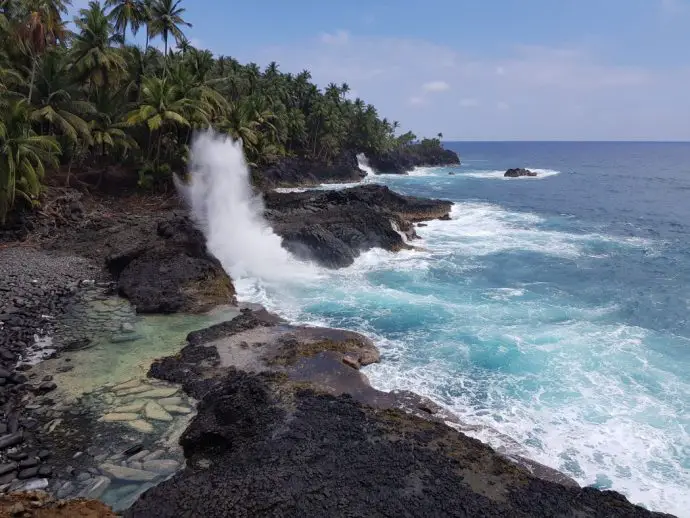
“Piscina” means “swimming pool”, and you’ll find lots of calm little pools which are perfect for taking a dip. It’s one of the best places to swim in São Tomé! The sand here is golden and the shoreline is fringed with palm trees – you really couldn’t ask for a prettier beach.
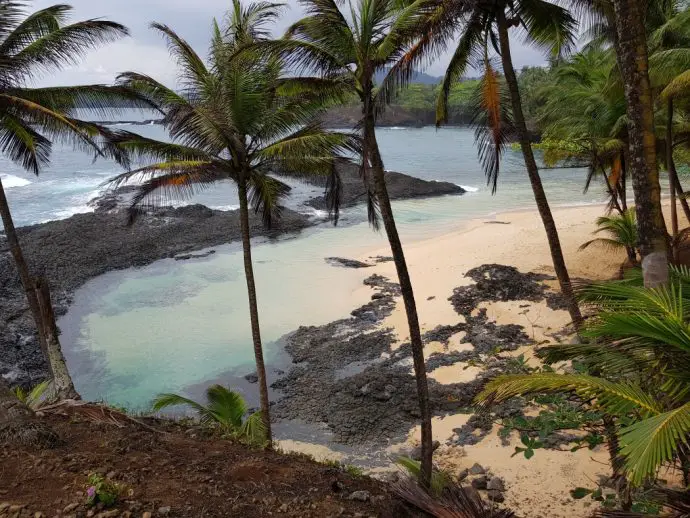
Agostinho produced some tasty local snacks beneath the shade of the palm grove, and we dug into banana chips, cookies, bread, and tea. We were disappointed that we didn’t have long to spend at the beach (a swim would have been magic), but with so many things to fit into the São Tomé day trip it was onwards and upwards. On our next visit to the islands we’ll definitely factor in a whole day here!
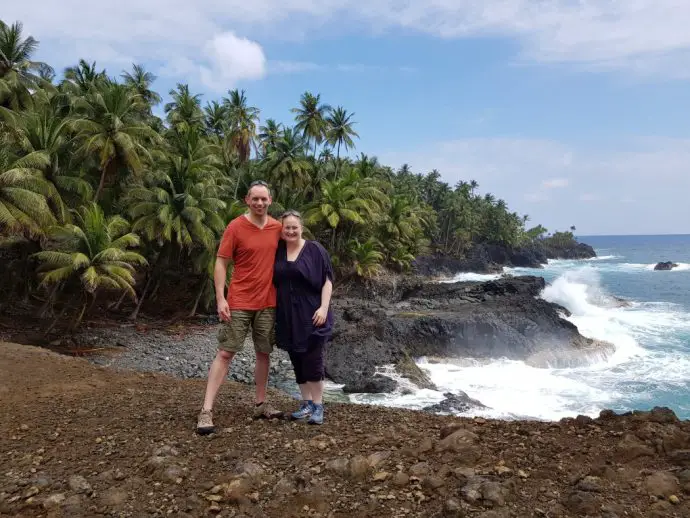
Read More: The Ultimate 10-day São Tomé and Príncipe itinerary
6. Roça São João dos Angolares
After our short beach visits it was foot on the gas all the way to our next stop – for lunch – at Roça São João dos Angolares. For reasons we are yet to fathom, we were two hours late, which meant the experience was rather rushed and we were lucky they had some food left. We’d already missed out some of the stops on the scheduled itinerary, but hadn’t lingered for long at any of the sights, so the timing fail really was a mystery to us. Perhaps we weren’t meant to go on the canoe trip? Who knows.
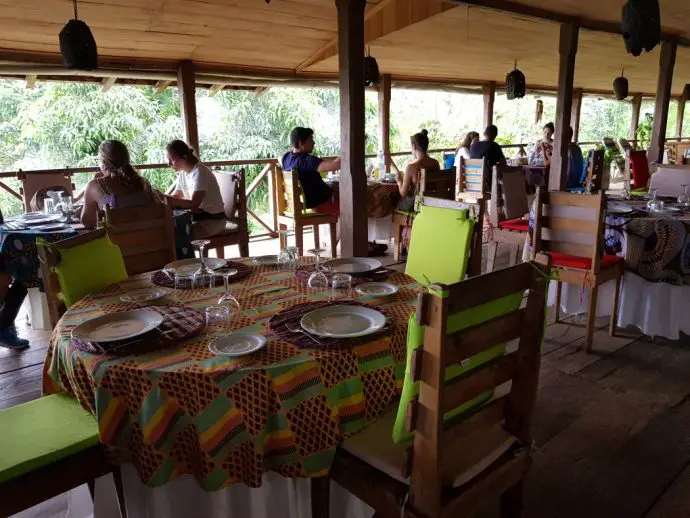
Another thread in the rich cultural tapestry on São Tomé is the community of Angolares, descendants of Angolan slaves who escaped a shipwreck off the coast of the island in 1540. Originally bound for Brazil, these survivors maintained a secretive presence on São Tomé, building settlements along the coast and becoming fishermen. These villages of Angolares remain here today, and the inhabitants still speak the old Angolares language.
The Roça São João dos Angolares is one of the most renowned eateries on the island, and a popular spot to stop for lunch on a São Tomé day trip. Owner João Carlos Silva was born on a nearby plantation, and left to travel the world before becoming a famous TV chef in Portugal. He eventually returned to São Tomé and restored Roça São João, where his father had once worked as plantation manager. The delightful open-sided building is now a small guest house, and relaxed gourmet restaurant with a tasting menu and a cooking school where local youngsters are being trained in the art of cuisine. We loved the open kitchen were we could watch the masters at work!
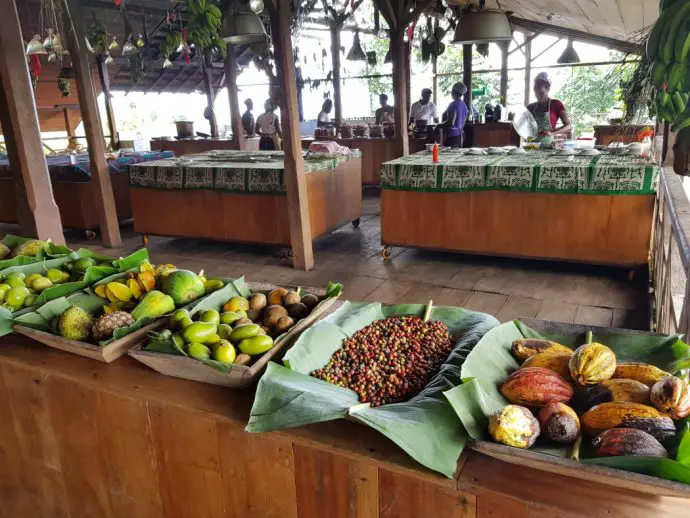
The afternoon rains had arrived, and it was quite fun and refreshing to sit at our table on the balcony, watching the watery torrents bouncing off the foliage all around. When the weather cleared up we could see the village of São João down on the coast below.
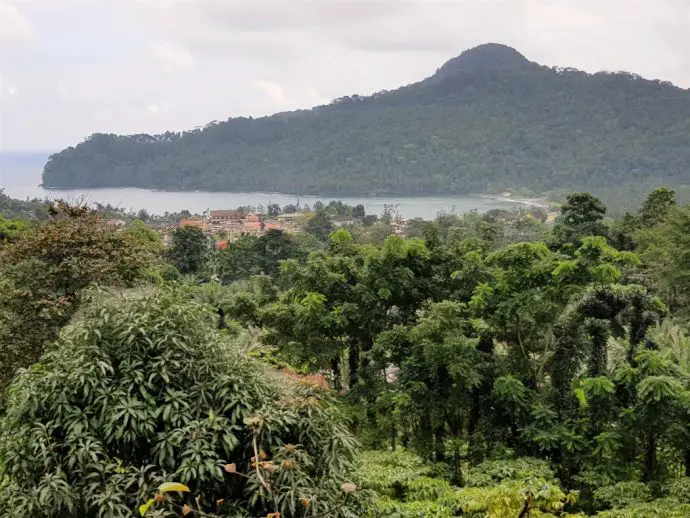
Lunch turned out to be a 7-course tasting menu, which seemed to be variations on a theme of tuna. Fish is a huge part of the diet here in São Tomé and Príncipe, so be prepared to eat a lot of it if you’re visiting! It was actually super tasty, and expertly presented – we could have been in a gourmet restaurant anywhere in the world! We wolfed down the courses since we were so behind with the schedule, and the chefs probably wanted to wrap up service. Luckily the dishes were small, so indigestion didn’t set in.
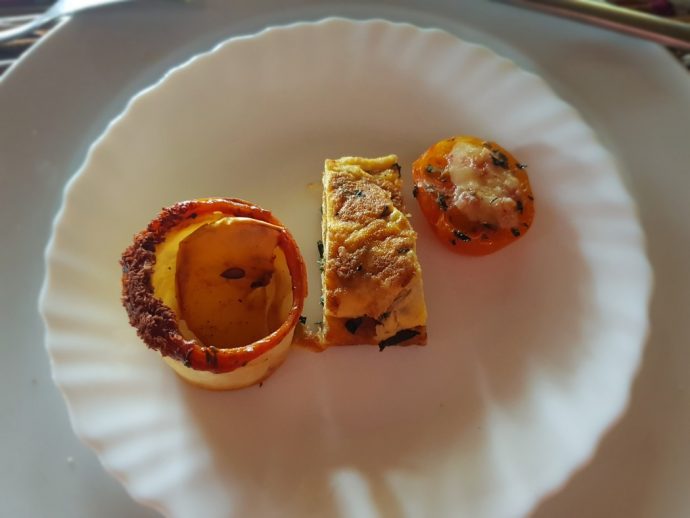
7. Roça Água Izé
This crumbling hospital was the last place we’d expected to find life, but here in the abandoned remains of what was once one of the largest cacao plantations on São Tomé, we discovered an entire community. Children scampered around shrieking as they chased one another through the dark rooms in the ultimate game of hide and seek. Pigs snuffled in the undergrowth, always searching for the next meal, whilst women laid out washing to dry on walls that were still warm from the heat of the day. We felt like intruders as we crept around Roça Água Izé but felt privileged to have had this brief glimpse into real life on São Tomé.
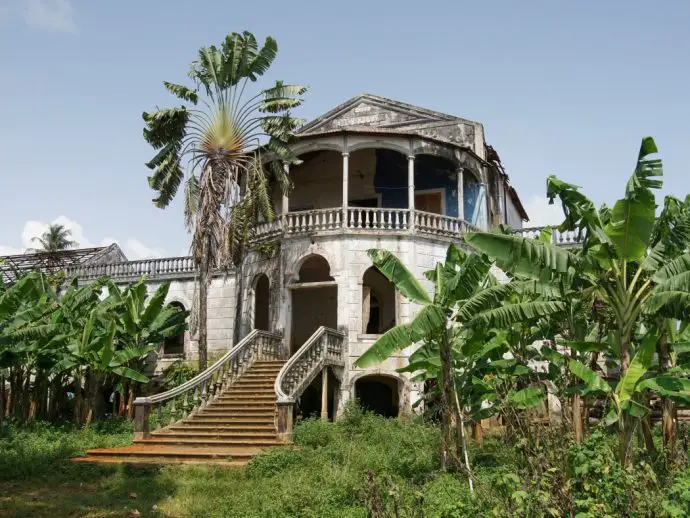
Agostinho seemed quite surprised that we wanted to visit Roça Água Izé on our São Tomé day trip. He was going to miss it out, even though it had been on the itinerary, presumably to make up a bit of that mysterious lost time. I’m glad we insisted. He responded to our quizzical glances at the decaying walls, which were slowly being swallowed by the surrounding forest. He told us that despite the Governor declaring the building unsafe and uninhabitable, the local people in this area keep returning to eke out an existence here as they simply have nowhere else to go. Their ancestors will have lived and toiled on the plantation, which at its peak in the 20th century had 2,500 workers. It’s the only home they know.
Despite the unmistakable poverty of these people, they remain proud and friendly. Even to us foreigners! Rather than demanding payment from the camera-toting tourists, the children stopped to wave or offer a shy Olá, quickly followed by huge grins when their calls were answered. The braver ones even came running up for hugs. It took a while for our Western cynicism to wear off, but when it did, we realised that once again these were genuine interactions. The sort you’ll rarely encounter elsewhere in the world.
Tourism is such a relatively new phenomenon in São Tomé and Príncipe that the scams and blatant requests for money we’ve learned to live with on our travels just don’t exist here. Not yet anyway. Life in São Tomé is simple, and often hard, but the islanders have the enviable talent of finding and embracing the joys of every day. It left us humbled and enchanted.
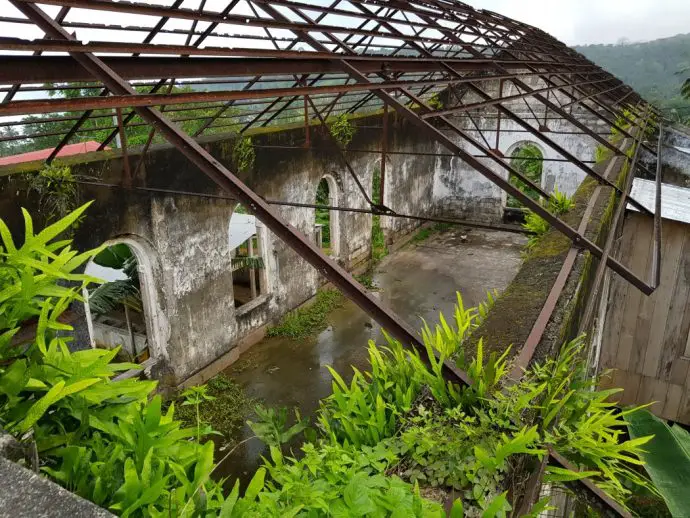
São Tomé wasn’t always inhabited, and even today the landscape appears little changed from what it must have been like before human settlement. Discovered in 1470 by Portuguese explorers João de Santarém and Pedro Escobar, São Tomé began to thrive on a pioneering industry built around plantations thanks to the incredibly fertile land on the islands. Slaves from Africa were brought to São Tomé and Principe to work on sugar cane, cacao and coffee estates.
When slavery was abolished in 1869, plantation owners began to employ serviçais (bonded workers) from Cape Verde, Angola and even as far away as Mozambique. Many of these serviçais were then stranded on the islands with no way to return home, despite prior promises from the authorities. They continued living at the plantations even when the industry fell into decline after independence from Portugal in 1975, and today their descendants walk the same corridors, and tend the same patches of land. Life now is centred on subsistence farming and fishing, with the shells that remain of the plantations providing a little comfort for those who have remained. Today both islands are a patchwork of overgrown plantations, hidden away in the thick tropical forest that cloaks much of the landscape, and to visit at least one is a must on any São Tomé day trip.
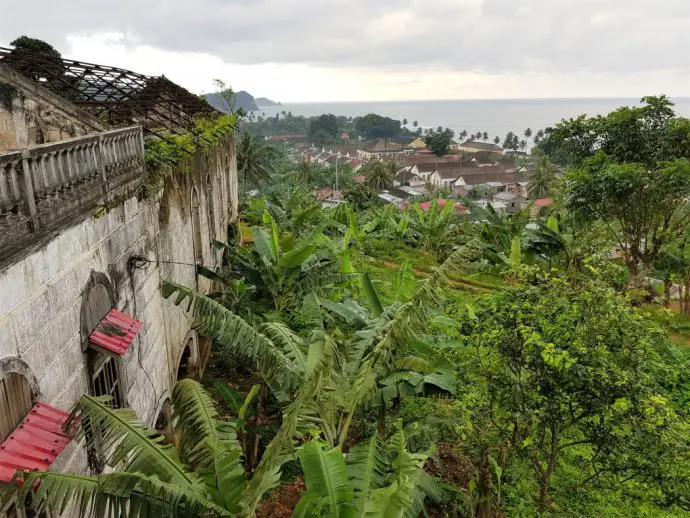
Dating back to the 1910s, Roça Água Izé on the east coast was one of the original ‘Big Five’ roças of São Tomé, and where the island’s cocoa industry began. African contract workers once lived here, and you can still see the grid of living quarters, streets, and squares that made up this community.
If you have time during your São Tomé day tour have a wander along the old railway tracks, past the cocoa and copra storehouses and the workshops to get a taste of what planation life was life. There was also a palm oil factory, several foundries, and a school for the worker’s children. Two hospitals were constructed, one for people of colour, and one for the whites. It was the latter that we visited, since the former is still officially inhabited.
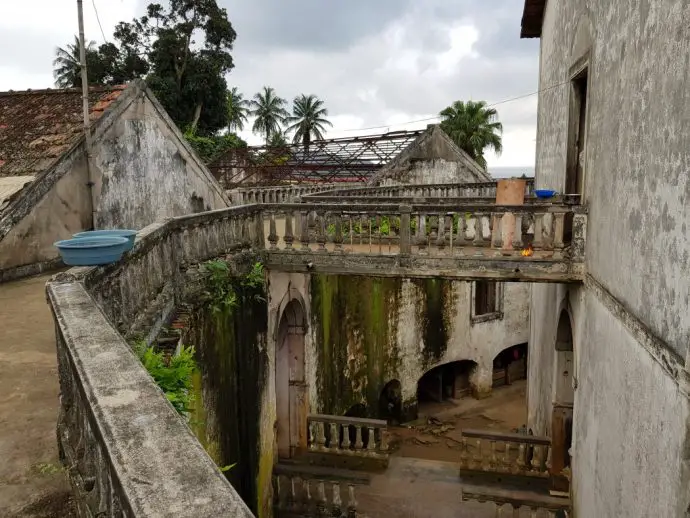
Cocoa beans are still farmed here, albeit at a much reduced rate of production, and locals grow small-scale subsistence crops here to survive. It’s quite eye-opening to consider that the fate of these people has been so firmly linked to the humble cocoa bean for this long. While a chocolate revival on the same scale is unlikely, there have been new pioneers emerging over recent decades to once again wield the bean on a global stage. Claudio Corallo is one such entrepreneur, using his plantation on Príncipe to produce some of the purest chocolate you will ever taste.
8. São Tomé City
The capital of the islands is São Tomé City, a sprawling ensemble of crumbling colonial houses, surprisingly quiet streets, and markets selling an assortment of goats, chickens, and unidentifiable fruit. It’s one of Africa’s oldest colonial cities, founded back in the 15th century by the Portuguese.
The highlights for tourists are the 16th-century cathedral and Fort São Sebastião which was built to defend against pirate attacks, and today houses the São Tomé National Museum. We didn’t have time to pop in but apparently there are religious and colonial artifacts on display inside.
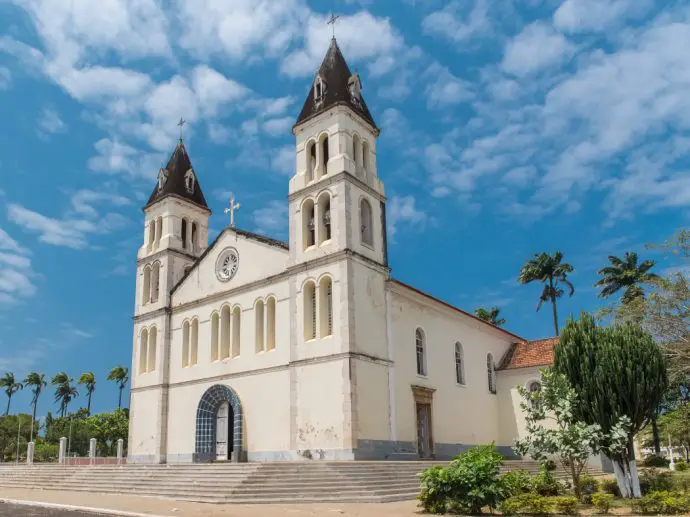
Read More: Best places to stay in São Tomé and Príncipe
The Verdict
To thrive in São Tomé and Príncipe as a tourist, you have to chill out, and just go with the flow. Leve-leve (slowly-slowly) rules here, and if you don’t embrace that, you risk letting a little ‘Western’ frustration creep into the experience. We were fully aware of this before our trip, and indeed this had put us off coming here a few years earlier after similar time-keeping issues in Brazil threatened to ruin our trip. So the fact that things didn’t go quite according to schedule on our São Tomé excursion wasn’t a major problem, although we would have liked to have seen the Boca do Inferno and Pesqueira beach waterfalls. Maybe next time!
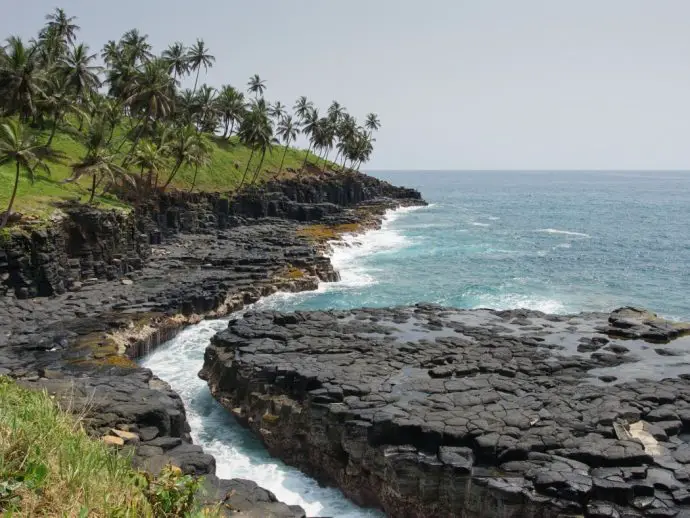
We loved that the whole São Tomé day trip felt like a bit of an adventure. I think in the end we did see two other tourists, but that was it! It’s rare to find somewhere so untouched by tourism that you feel like you’re having a truly genuine experience, and I wonder how long it will remain like this in São Tomé and Príncipe.
São Tomé may be a small island, but don’t be fooled into thinking travel times will be correspondingly short. The roads aren’t in tip top condition, and the challenges of potholes, landslides and rogue piglets mean journeys take far longer than you’d expect. Of our 8-hour day trip on São Tomé, five of those hours were spent on the road.
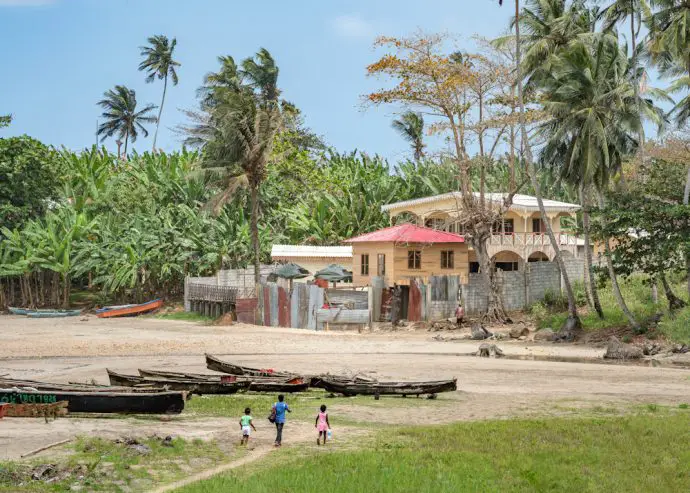
Read More: An introduction to São Tomé and Príncipe for first-time visitors
How to Book a São Tomé day tour
The best way to arrange a São Tomé day trip is through your accommodation, as it’s almost impossible to book anything online with a third party ahead of your visit. You can wait until you arrive or discuss your requirements by email in advance, but if you’re stopping on the island for more than a day, it will probably just be easier to make arrangements with reception in person.
How much does a São Tomé day trip cost?
This really depends on who you book through, but remember most tours are pretty much the same. There’s little variation in the standard of vehicle (you make do with what they’ve been able to import onto the island!), so prices shouldn’t differ much between operators.
We paid €80 per person in 2019 for a 6-hour private São Tomé tour (which ended up being 8 hours), that included both a driver and a guide. There was a supplement of €15 each for the lunch at Roca Sao Joao Angolares. Despite apparently missing out several of the scheduled stops on the itinerary, we felt it was good value for money.
Other day trips on São Tomé
The other recommended day tour of São Tomé is the ‘Central Trip‘, which focuses more on the coffee plantations up in the mountains, with waterfalls and views down over São Tomé City. You’ll visit Sao Nicolau waterfall and the Monte Café plantation which is the largest and most prosperous estate on the island.
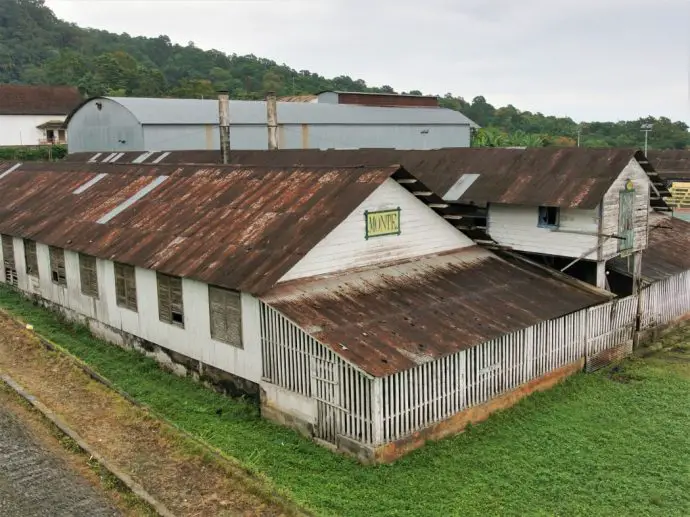
The roads and hiring a car on São Tomé
The road conditions on São Tomé are pretty much as you’d expect for a small, relatively undeveloped tropical island in the middle of the ocean. There’s basically one main highway that runs north to south around the eastern flank of São Tomé, with a smattering of smaller roads heading inland.
The major road is sealed near the towns, but don’t be fooled into going at any great speed, because just around the corner there will be an assortment of pigs, felled trees, and the odd landslide to contend with. Not to mention the potholes which are left to add an element of surprise to your journey. Away from the main settlements the roads are made of stones in places, giving a real bone shaker of a ride. Don’t eat too much for breakfast is our advice!
If you’re up for a bit of an adventure and want to do your own São Tomé tour, you can hire a vehicle on São Tomé and explore at your own pace. If you do, make sure you get a 4×4 because most of the sights are down plantation tracks, some of which aren’t negotiable by car. And take with you a sense of humour, because once you’re off the main road, there are very few signs and if we hadn’t been with a guide we’d have got completely lost. There weren’t many people around to ask for directions either (this is proper remote territory), so be prepared.
If you do want to rent a car, then it’s best to arrange this via your hotel. Most can do this on arrival, but if your accommodation is a long way from the city, you might want to discuss it before your trip, just to make sure. There are several car hire companies available, although we can’t recommend any as we haven’t personally used them. It should cost around €50 a day to hire something like a Suzuki Jimny with a single driver.

